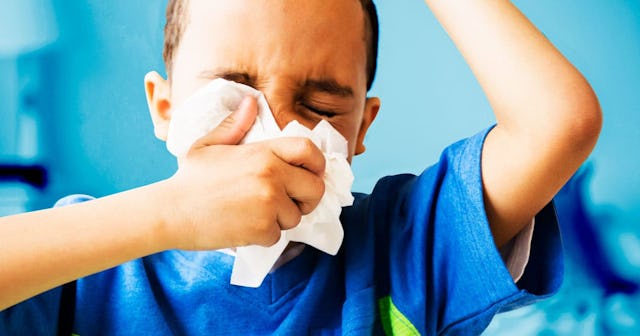You Need To Teach Your Kids About Food Allergies (Even If They Don't Have Them)

Two-year-olds are not known for sharing. A recent Google search on the topic generated more than 100 million results: psychologists provide how-to guides on teaching your toddler to share, and parents swap tales of sharing-related tantrums at the playground. Maybe that’s why I was so surprised when my daughter’s playmate “shared” his ice cream by shoving it in her mouth.
His mother smiled proudly and praised him for being so thoughtful, but I began to panic. I grabbed a napkin and frantically attempted to wipe the ice cream off her tongue, and then began pouring water on her face while people stopped and stared at what must have looked like a crazy scene. My daughter has a life-threatening egg allergy, and the third ingredient in the ice cream was egg.
At four, she carries an EpiPen wherever she goes. I grill waiters at restaurants and warn her friends’ parents when she goes on playdates. Despite our efforts, she has still been to the emergency room numerous times. How do you educate a toddler to abstain from the endless stream of cupcakes and cookies brought to her daycare for birthdays, holidays, and (in one particularly scary episode) Teacher Appreciation Day?
To be sure, we are lucky. Other than the allergy, our daughter is healthy, and we have excellent medical care. We were even able to secure EpiPens during the recent shortage. But our luck could change if we stopped obsessively reading ingredients. Or if we left our child alone with the family friend who insists we are overreacting and tries to share french fries that drip with egg-laden mayonnaise. “Kids these days and their allergies. When I was young, people didn’t have all these allergies,” he says. And then comes the label: “helicopter parent.”
The irony is that the family friend is not wrong about one claim: Food allergies have been increasing. But it is not because millennial parents are coddling their children.
According to Food Allergy Research and Education (FARE), a Virginia-based nonprofit, approximately 32 million people in the United States have food allergies, including one child in every thirteen. Food allergies send someone to the emergency room every three minutes, and more than 40 percent of children with food allergies have experienced a severe allergic reaction such as anaphylaxis.
Andrew Lichtenstein/Getty
Anaphylaxis causes the body’s immune system to release a flood of chemicals that can lead to shock: Blood pressure drops suddenly and narrowed airways block breathing. Many have described the experience as terrifying – patients often say they feel as if they are dying. I don’t know how my daughter felt when her airway started tightening, because she was too young to have the words to express herself. But I will never forget the confusion in her eyes, the beeping of the monitors, and the tubes pumping medicine into her tiny body. If anaphylaxis is not treated immediately, it can be fatal. Hence the EpiPen that my daughter carries at all times in her little blue owl backpack (because “blue is my favorite color”).
The Centers for Disease Control & Prevention found that food allergies rose among children by 50 percent between 1997 and 2011. Peanut allergies, once uncommon, tripled in children between 1997 and 2008. Beyond just an issue of health, allergies have economic implications. Caring for children with food allergies costs U.S. families close to $25 billion a year.
If the surge in food allergies can’t be attributed to millennial angst, what is causing it? Contrary to some beliefs, the growth is not a result of greater awareness or better diagnoses than in the past. Nor can the rate be attributed to genetics.
While research is still preliminary, environmental causes appear to be likely culprits. Allergies are higher in urban areas than in rural areas, and factors could include exposure to pollution and dietary changes. According to a recent study in Frontiers in Immunology, changes in the human microbiome may play a role. The microbiome is the community of microbes, including bacteria and fungi, that lives in our guts and other parts of our body. The estimated 1,500 species of bacteria that comprise the microbiome maintained a symbiotic relationship with our bodies during millions of years of co-evolution. Scholars speculate that increased exposure to antibiotics and antimicrobial compounds in the environment could be altering the symbiotic relationship and changing how our immune systems respond to potential allergens, such as eggs and peanuts.
We need to translate awareness into supporting research that seeks to explain why allergies are increasing and whether we might be able to cure them. We need to expand healthcare coverage to ensure that every child who needs an EpiPen can have access to one. People should not have to rely on GoFundMe campaigns for this lifesaving medicine. But we can also translate this awareness into smaller, more immediately achievable actions, such as learning the simple steps you can take to keep children with food allergies safe in your homes, schools, and communities.
My daughter is older now. She knows to ask about food ingredients, and we have learned to bring vegan treats to birthday parties so she can join in the festivities. She still occasionally feels left out. I see her wince when a classmate tells her, “You can’t eat anything fun.” But these experiences are building her resilience and empathy for others, not making her a coddled “snowflake.” “I can eat lots of fun things,” she tells her classmate. “I can eat popsicles.” And she grabs her little blue owl backpack and runs to the monkey bars.
This article was originally published on